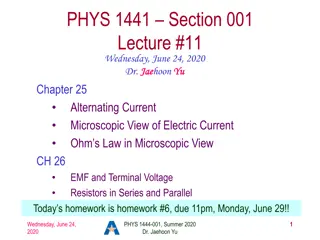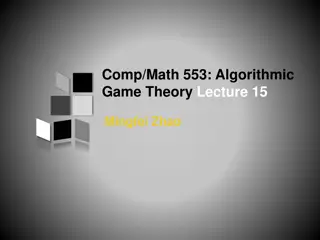
Efficient Data Handling with Java Collections
Learn efficient data handling techniques in Java using collections. Explore how to read and manipulate words from a file, capitalize plurals, display in reverse order, and remove plural words. Understand the drawbacks of using arrays and discover the benefits of Java collections like ArrayList for dynamic data storage.
Download Presentation

Please find below an Image/Link to download the presentation.
The content on the website is provided AS IS for your information and personal use only. It may not be sold, licensed, or shared on other websites without obtaining consent from the author. If you encounter any issues during the download, it is possible that the publisher has removed the file from their server.
You are allowed to download the files provided on this website for personal or commercial use, subject to the condition that they are used lawfully. All files are the property of their respective owners.
The content on the website is provided AS IS for your information and personal use only. It may not be sold, licensed, or shared on other websites without obtaining consent from the author.
E N D
Presentation Transcript
Exercise Write a program that reads a file and displays the words of that file as a list. oFirst display all words. oThen display them with all plurals (ending in "s") capitalized. oThen display them in reverse order. oThen display them with all plural words removed. Should we solve this problem using an array? oWhy or why not?
Naive solution String[] allWords = new String[1000]; int wordCount = 0; Scanner input = new Scanner(new File("data.txt")); while (input.hasNext()) { String word = input.next(); allWords[wordCount] = word; wordCount++; } Problem: You don't know how many words the file will have. oHard to create an array of the appropriate size. oLater parts of the problem are more difficult to solve. Luckily, there are other ways to store data besides in an array.
Collections collection: an object that stores data othe objects stored are called elements osome collections maintain an ordering; some allow duplicates otypical operations: add, remove, clear, contains (search), size oexamples found in the Java class libraries: ArrayList, LinkedList, HashMap, TreeSet, PriorityQueue oall collections are in the java.util package import java.util.*;
Lists list: a collection storing an ordered sequence of elements oeach element is accessible by a 0-based index oa list has a size oelements can be added to the front, back, or elsewhere oin Java, a list can be represented as an ArrayList object
Idea of a list Rather than creating an array of boxes, create an object that represents a "list" of items. (initially an empty list.) [] You can add items to the list. oThe default behavior is to add to the end of the list. [hello, ABC, goodbye, okay] The list object keeps track of the element values that have been added to it, their order, indexes, and its total size. oThink of an "array list" as an automatically resizing array object. oInternally, the list is implemented using an array and a size field.
ArrayList methods add(value) add(index, value) appends value at end of list inserts given value just before the given index, shifting subsequent values to the right removes all elements of the list returns first index where given value is found in list (-1 if not found) returns the value at given index removes/returns value at given index, shifting subsequent values to the left replaces value at given index with given value returns the number of elements in list returns a string representation of the list such as "[3, 42, -7, 15]" clear() indexOf(value) get(index) remove(index) set(index, value) size() toString()
ArrayList methods 2 addAll(list) addAll(index, list) contains(value) containsAll(list) equals(list) iterator() listIterator() lastIndexOf(value) returns last index value is found in list (-1 if not found) remove(value) finds and removes the given value from this list removeAll(list) removes any elements found in the given list from this list retainAll(list) removes any elements not found in given list from this list subList(from, to) returns the sub-portion of the list between indexes from (inclusive) and to (exclusive) toArray() returns the elements in this list as an array adds all elements from the given list to this list (at the end of the list, or inserts them at the given index) returns true if given value is found somewhere in this list returns true if this list contains every element from given list returns true if given other list contains the same elements returns an object used to examine the contents of the list (seen later)
Type Parameters (Generics) ArrayList<Type> name = new ArrayList<Type>(); When constructing an ArrayList, you must specify the type of elements it will contain between < and >. oThis is called a type parameter or a generic class. oAllows the same ArrayList class to store lists of different types. ArrayList<String> names = new ArrayList<String>(); names.add("Bert"); names.add("Ernie");
Learning about classes The Java API Specification is a huge web page containing documentation about every Java class and its methods. oThe link to the API Specs is on the instructor web site (under Resources).
ArrayList vs. array construction String[] names = new String[5]; ArrayList<String> list = new ArrayList<String>(); storing a value names[0] = "Jessica"; list.add("Jessica"); retrieving a value String s = names[0]; String s = list.get(0);
ArrayList vs. array 2 doing something to each value that starts with "B" for (int i = 0; i < names.length; i++) { if (names[i].startsWith("B")) { ... } } for (int i = 0; i < list.size(); i++) { if (list.get(i).startsWith("B")) { ... } } seeing whether the value "Benson" is found for (int i = 0; i < names.length; i++) { if (names[i].equals("Benson")) { ... } } if (list.contains("Benson")) { ... }
Exercise, revisited Write a program that reads a file and displays the words of that file as a list. oFirst display all words. oThen display them in reverse order. oThen display them with all plurals (ending in "s") capitalized. oThen display them with all plural words removed.






















